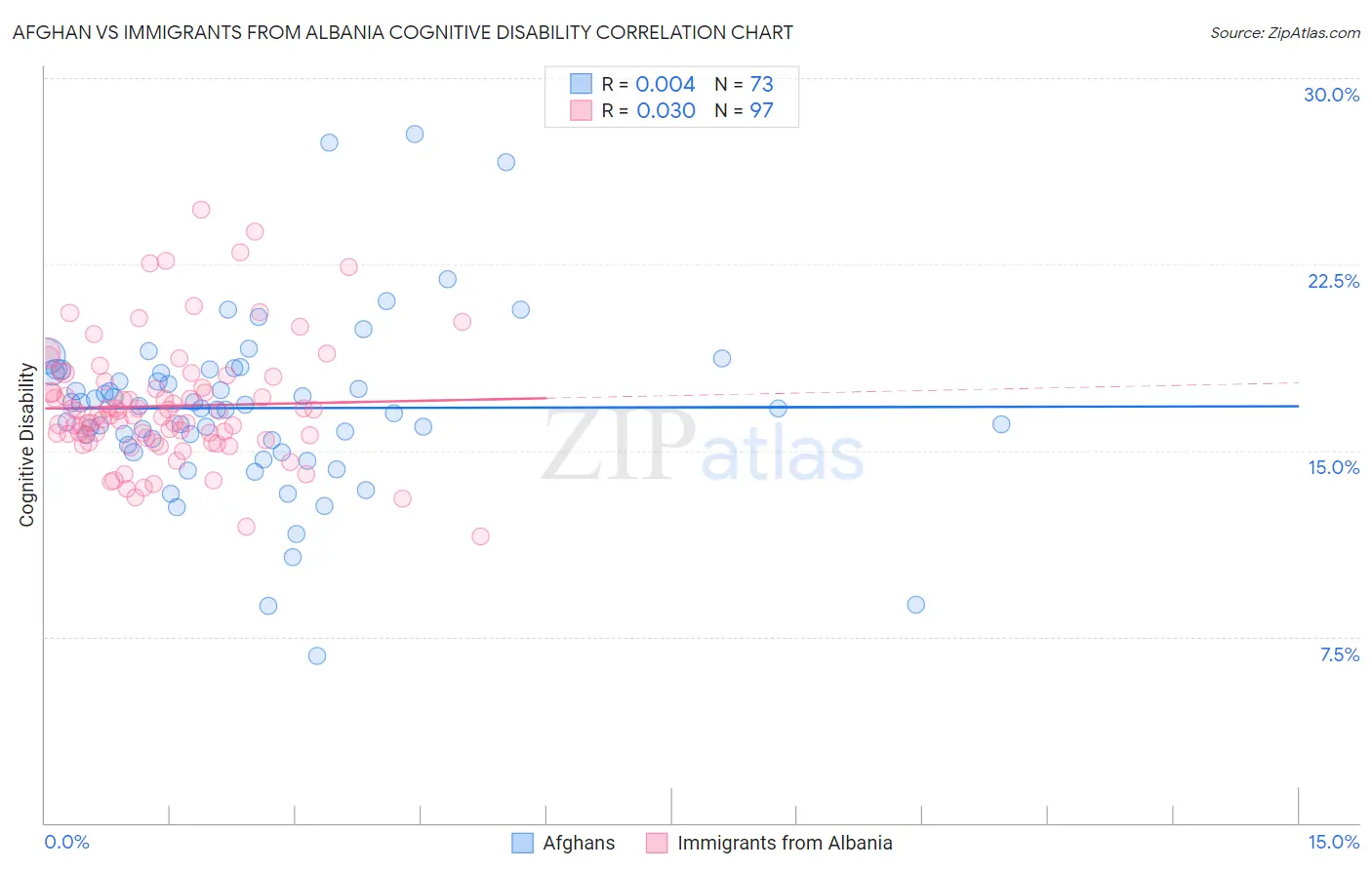Afghan vs Immigrants from Albania Cognitive Disability
COMPARE
Afghan
Immigrants from Albania
Cognitive Disability
Cognitive Disability Comparison
Afghans
Immigrants from Albania
17.3%
COGNITIVE DISABILITY
38.2/ 100
METRIC RATING
185th/ 347
METRIC RANK
17.2%
COGNITIVE DISABILITY
64.9/ 100
METRIC RATING
165th/ 347
METRIC RANK
Afghan vs Immigrants from Albania Cognitive Disability Correlation Chart
The statistical analysis conducted on geographies consisting of 148,870,382 people shows no correlation between the proportion of Afghans and percentage of population with cognitive disability in the United States with a correlation coefficient (R) of 0.004 and weighted average of 17.3%. Similarly, the statistical analysis conducted on geographies consisting of 119,394,902 people shows no correlation between the proportion of Immigrants from Albania and percentage of population with cognitive disability in the United States with a correlation coefficient (R) of 0.030 and weighted average of 17.2%, a difference of 0.78%.

Cognitive Disability Correlation Summary
| Measurement | Afghan | Immigrants from Albania |
| Minimum | 6.7% | 11.6% |
| Maximum | 27.8% | 24.7% |
| Range | 21.0% | 13.2% |
| Mean | 16.7% | 16.8% |
| Median | 16.7% | 16.4% |
| Interquartile 25% (IQ1) | 15.3% | 15.5% |
| Interquartile 75% (IQ3) | 18.2% | 17.7% |
| Interquartile Range (IQR) | 2.9% | 2.2% |
| Standard Deviation (Sample) | 3.5% | 2.4% |
| Standard Deviation (Population) | 3.5% | 2.4% |
Demographics Similar to Afghans and Immigrants from Albania by Cognitive Disability
In terms of cognitive disability, the demographic groups most similar to Afghans are Crow (17.3%, a difference of 0.030%), Spaniard (17.3%, a difference of 0.060%), Immigrants from Guyana (17.3%, a difference of 0.14%), Arab (17.3%, a difference of 0.14%), and Pakistani (17.3%, a difference of 0.17%). Similarly, the demographic groups most similar to Immigrants from Albania are Immigrants from Ecuador (17.2%, a difference of 0.010%), Immigrants from Syria (17.2%, a difference of 0.040%), Immigrants (17.2%, a difference of 0.070%), Immigrants from Portugal (17.2%, a difference of 0.090%), and Ecuadorian (17.2%, a difference of 0.16%).
| Demographics | Rating | Rank | Cognitive Disability |
| Immigrants | Albania | 64.9 /100 | #165 | Good 17.2% |
| Immigrants | Ecuador | 64.4 /100 | #166 | Good 17.2% |
| Immigrants | Syria | 63.5 /100 | #167 | Good 17.2% |
| Immigrants | Immigrants | 62.5 /100 | #168 | Good 17.2% |
| Immigrants | Portugal | 61.8 /100 | #169 | Good 17.2% |
| Ecuadorians | 59.6 /100 | #170 | Average 17.2% |
| Tlingit-Haida | 59.4 /100 | #171 | Average 17.2% |
| Immigrants | Turkey | 56.7 /100 | #172 | Average 17.2% |
| Immigrants | Northern Africa | 50.2 /100 | #173 | Average 17.3% |
| Laotians | 50.0 /100 | #174 | Average 17.3% |
| Tsimshian | 49.8 /100 | #175 | Average 17.3% |
| Shoshone | 49.2 /100 | #176 | Average 17.3% |
| Ute | 49.1 /100 | #177 | Average 17.3% |
| Spanish | 48.9 /100 | #178 | Average 17.3% |
| Sioux | 48.6 /100 | #179 | Average 17.3% |
| Pakistanis | 43.9 /100 | #180 | Average 17.3% |
| Immigrants | Guyana | 42.9 /100 | #181 | Average 17.3% |
| Arabs | 42.8 /100 | #182 | Average 17.3% |
| Spaniards | 40.3 /100 | #183 | Average 17.3% |
| Crow | 39.1 /100 | #184 | Fair 17.3% |
| Afghans | 38.2 /100 | #185 | Fair 17.3% |